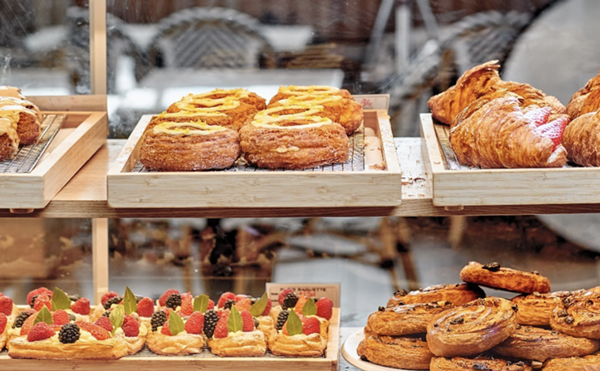Clash of the Casseroles: Is Texas Potluck Standby King Ranch Chicken Worth Making From Scratch? Time To Find Out.
By Ron Bechtol on Mon, Jun 15, 2020 at 9:30 am
First know this: King Ranch Chicken, the loved or loathed casserole that became a staple at weddings, funerals and pot-luck suppers all over Texas, likely has nothing to do with the fabled spread. Cows, not hens, were the engine of famed rancher Richard King’s success.
It’s now thought instead that the concoction, based on mushroom and chicken canned soups combined with tinned tomatoes with chilies — Texas-born Ro-Tel to be precise — originated with post-war wives yearning to be liberated from the drudgery of housework and was disseminated throughout the state and beyond via Junior League cookbooks. A from-scratch variation on the dish was popularized by the chef at the San Antonio Junior League’s Bright Shawl Tearoom in the years prior to its 2013 closing.
There are many recipes that purport to be the “original,” but one in The Casserole Queens Cookbook by Sandy Pollock and Crystal Cook seems to be as good a baseline as any. The only gussying up in that version is the use of cooking spray. Otherwise, it’s Campbell’s (one imagines) all the way. And that version does carry on the tradition of using Ro-Tel, even citing it by name.
Recently, upscaled renditions have been offered by other Texas cookbook authors, including pastry queen Rebecca Rather and Austin-based Jessica Dupuy. Dupuy’s United Tastes of Texas was published in 2016. That recipe was one of the factors that sparked me to undertake a cans-versus-scratch confrontation between two different pans of the Texas casserole staple.
The other was a foil pan of King Ranch Chicken I discovered in the freezer chest at Cooper’s Meat Market on Broadway just before the pandemic. Its menu listed all the usual suspects, including “rotel” and “cream soup.” And since it only needed to be defrosted and baked, it seemed to be even more liberating than the original — and a perfect, ahem, foil to play against an update. As both required the same oven temperature and more or less the same time, I could do them together and conduct a side-by-side comparison.
Somewhat grudgingly admitting its importance, Texas Monthly once described King Ranch Chicken as “not a pretty dish. A steaming mass of melted mush, the ingredients … make it a study in beige and yellow. Nor is it at all exciting. Even with the requisite Ro-Tel tomatoes and green chilies, the flavor is resolutely bland.” At first glance, this perfectly described the look of the Cooper’s contribution as it emerged from the oven. In an act of charity, I added chopped Italian parsley.
The texture of the dish also approached the mass-of-melted mush description: the tortillas had effectively disintegrated. But it was decently cheesy, and the taste proved better than bland, especially if you’re a fan of Tex-Mex flavors such as cumin and chili powder. The medium container —more or less the same size as the next recipe — set me back $34.
You can google Dupuy’s KRC recipe, for which I did all my shopping at Central Market due to their well-run pandemic-era operation. For starters, be aware that two, oak-roasted chickens are perfect for the amount of smoked bird she calls for. Those will set you back about $16. I added some Spanish pimento ahumado to make up for the lack of actual smoke.
I also made other tweaks and substitutions, some out of one-stop shopping necessity, some because I rarely follow recipes exactly anyway. For example, she calls for poblano peppers but doesn’t ask you to char them and rub off the skins, which I did. For the chili powder, I used one-third chili powder (Gebhardt’s makes it more local), one-third dark ancho chile powder (this time with an “e” instead of an “i”) and one-third smoked pimento. I reduced the amount of cumin but toasted the seeds first in a dry pan, then ground them coarsely.
In an attempt — my guess, anyway — at not having the tortillas turn to mush, DuPuy has you toast them, brushed with oil, in a cast-iron skillet. The ploy works almost too well when it comes to the top layer, as they get too crisp to cut through easily. Leaving the other layers whole, I’d quarter the ones on top. But, otherwise, the verdict was positive. There was a good ratio of chicken to other components, and the flavors were robust. It also looked good — even without parsley.
But was it all worth the time and expense? Not counting shopping time, assembly took over an hour what with all the charring, chopping, frying and toasting of 18 tortillas. Also not counting ingredients I already had, such as chicken stock and sour cream, the cost was about $30, making that aspect a wash.
In the end, there was no clear winner. Sheer convenience suggests the frozen route, while cheffy pride tugs in the other direction. Your call, should pot-lucks ever rise again.
So many restaurants, so little time. Find out the latest San Antonio dining news with our Flavor Friday Newsletter.
It’s now thought instead that the concoction, based on mushroom and chicken canned soups combined with tinned tomatoes with chilies — Texas-born Ro-Tel to be precise — originated with post-war wives yearning to be liberated from the drudgery of housework and was disseminated throughout the state and beyond via Junior League cookbooks. A from-scratch variation on the dish was popularized by the chef at the San Antonio Junior League’s Bright Shawl Tearoom in the years prior to its 2013 closing.
There are many recipes that purport to be the “original,” but one in The Casserole Queens Cookbook by Sandy Pollock and Crystal Cook seems to be as good a baseline as any. The only gussying up in that version is the use of cooking spray. Otherwise, it’s Campbell’s (one imagines) all the way. And that version does carry on the tradition of using Ro-Tel, even citing it by name.
Recently, upscaled renditions have been offered by other Texas cookbook authors, including pastry queen Rebecca Rather and Austin-based Jessica Dupuy. Dupuy’s United Tastes of Texas was published in 2016. That recipe was one of the factors that sparked me to undertake a cans-versus-scratch confrontation between two different pans of the Texas casserole staple.
The other was a foil pan of King Ranch Chicken I discovered in the freezer chest at Cooper’s Meat Market on Broadway just before the pandemic. Its menu listed all the usual suspects, including “rotel” and “cream soup.” And since it only needed to be defrosted and baked, it seemed to be even more liberating than the original — and a perfect, ahem, foil to play against an update. As both required the same oven temperature and more or less the same time, I could do them together and conduct a side-by-side comparison.
Somewhat grudgingly admitting its importance, Texas Monthly once described King Ranch Chicken as “not a pretty dish. A steaming mass of melted mush, the ingredients … make it a study in beige and yellow. Nor is it at all exciting. Even with the requisite Ro-Tel tomatoes and green chilies, the flavor is resolutely bland.” At first glance, this perfectly described the look of the Cooper’s contribution as it emerged from the oven. In an act of charity, I added chopped Italian parsley.
The texture of the dish also approached the mass-of-melted mush description: the tortillas had effectively disintegrated. But it was decently cheesy, and the taste proved better than bland, especially if you’re a fan of Tex-Mex flavors such as cumin and chili powder. The medium container —more or less the same size as the next recipe — set me back $34.
You can google Dupuy’s KRC recipe, for which I did all my shopping at Central Market due to their well-run pandemic-era operation. For starters, be aware that two, oak-roasted chickens are perfect for the amount of smoked bird she calls for. Those will set you back about $16. I added some Spanish pimento ahumado to make up for the lack of actual smoke.
I also made other tweaks and substitutions, some out of one-stop shopping necessity, some because I rarely follow recipes exactly anyway. For example, she calls for poblano peppers but doesn’t ask you to char them and rub off the skins, which I did. For the chili powder, I used one-third chili powder (Gebhardt’s makes it more local), one-third dark ancho chile powder (this time with an “e” instead of an “i”) and one-third smoked pimento. I reduced the amount of cumin but toasted the seeds first in a dry pan, then ground them coarsely.
In an attempt — my guess, anyway — at not having the tortillas turn to mush, DuPuy has you toast them, brushed with oil, in a cast-iron skillet. The ploy works almost too well when it comes to the top layer, as they get too crisp to cut through easily. Leaving the other layers whole, I’d quarter the ones on top. But, otherwise, the verdict was positive. There was a good ratio of chicken to other components, and the flavors were robust. It also looked good — even without parsley.
But was it all worth the time and expense? Not counting shopping time, assembly took over an hour what with all the charring, chopping, frying and toasting of 18 tortillas. Also not counting ingredients I already had, such as chicken stock and sour cream, the cost was about $30, making that aspect a wash.
In the end, there was no clear winner. Sheer convenience suggests the frozen route, while cheffy pride tugs in the other direction. Your call, should pot-lucks ever rise again.
So many restaurants, so little time. Find out the latest San Antonio dining news with our Flavor Friday Newsletter.

KEEP SA CURRENT!
Since 1986, the SA Current has served as the free, independent voice of San Antonio, and we want to keep it that way.
Becoming an SA Current Supporter for as little as $5 a month allows us to continue offering readers access to our coverage of local news, food, nightlife, events, and culture with no paywalls.
Scroll to read more Flavor articles
Newsletters
Join SA Current Newsletters
Subscribe now to get the latest news delivered right to your inbox.


















